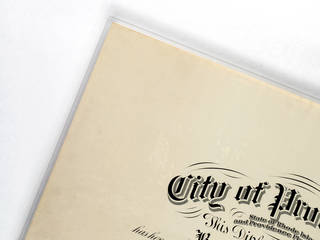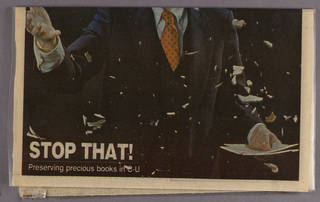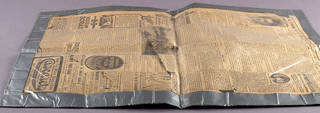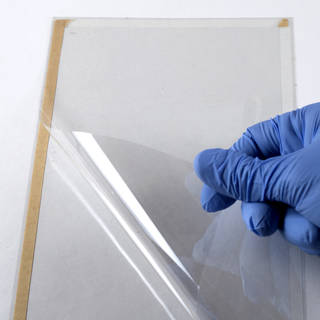
Preservation Self-Assessment Program
Lamination vs. Encapsulation
The terms "lamination" and "encapsulation" are often used interchangeably—and incorrectly so. Though it may sometimes be difficult to distinguish between encapsulated and laminated documents, there are clear differences between the two in both appearance and intention. An irreversible process, lamination employs adhesives and is intended for use on materials with a short life expectancy. In contrast, encapsulation, which is entirely reversible, does not use adhesives and is intended for long-term protection.

Lamination
Lamination is the process of completely sealing paper documents between sheets of plastic with heat and low-grade adhesives. This procedure irreversibly damages the enclosed item. The conventional method is heat-seal lamination, in which documents or book pages are placed in plastic pouches and sealed using heat, pressure, and adhesives. Heat-seal lamination cannot be undone because the heat melts adhesive into the document. This process is appropriate only for materials with a short term value—certainly not for your valued collection materials. Simply put, lamination should never be thought of as a preservation method.

Unfortunately, lamination was once considered a viable conservation method (this is likely where lamination misconceptions originate) as it was thought to strengthen and protect fragile paper. Over time however, it was discovered that lamination is in fact destructive. Not only does the application of high heat and pressure damage documents, laminate plastics will also "off-gas," causing a chemical reaction with materials sealed inside. Furthermore, the adhesives used in lamination are typically acidic and can thus adversely affected inks, causing them to bleed beyond their edges ("halo" effect) in printed and written material. Each of these factors cause and/or accelerate the deterioration of paper documents.

Encapsulation
Encapsulation is the process of completely enclosing documents between two clear sheets of uncoated polyester, which are sealed without adhesives and can therefore be easily removed without adverse effects. These polyester sheets create an electrostatic charge that holds the document in place. The edges of the polyester are either sealed or joined together on all sides using a variety of methods, including cloth stitching, double-sided tape (specifically 3M no. 415), and ultrasonic, thermal, or laser welding (the last of which is expensive yet ideal). If used, double-sided tape should be approached with caution since adhesives can easily transfer to and damage enclosed documents that come into contact with the enclosure's edges. This is particularly bad for heavy and/or thick items.

As encapsulation can be an expensive and time-consuming effort, this method of preservation is suitable for fragile documents, some photographic prints, certificates, and small textiles. It should also be noted that encapsulation is not recommended for artifacts with friable media (e.g. pencil, charcoal, chalk, color pencil) as the electrostatic charge causes the media to transfer onto the plastic. Photographic materials should be stored upright in a folder as to reduce the weight pressing the polyester film against the photographic emulsion.
Highly acidic items are known to deteriorate more rapidly when in a sealed polyester containment. In such cases, deacidification or washing will have to be performed by a professional prior to encapsulation. In lieu of this conservation work, an alkaline buffer sheet may be placed with the object to slow the acid degradation. An uncoated polyester film like Melinex type 516, which was previously marketed as Mylar type D and is generically referred to as Mylar, is recommended for encapsulation.